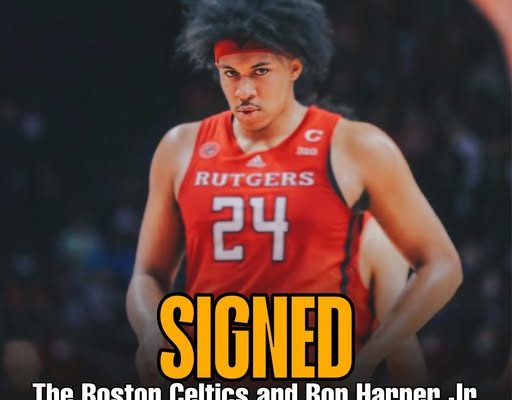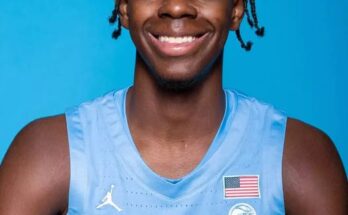Ron Harper Jr. has taken another meaningful step forward in his basketball journey, agreeing to a new deal with the Boston Celtics. After spending the past three NBA seasons with the Toronto Raptors and the Detroit Pistons, Harper is getting another shot at proving he belongs on a permanent NBA roster. For a player who has faced an uphill battle since going undrafted in 2022, this opportunity with one of the league’s most storied franchises could represent a turning point in his career. More than a name or a legacy, Harper Jr. is now trying to solidify his own place in the league, on his own merit, and at a critical time in his development.
Harper Jr.’s path to this point has been anything but linear. Coming out of Rutgers, where he played four seasons and developed into a reliable two-way contributor, he was seen as a high-IQ, physical wing who could shoot and defend across multiple positions. His senior year showed off real growth—averaging nearly 16 points per game while shooting close to 40 percent from three-point range. Despite this, he went undrafted in 2022, a decision that many observers found surprising. However, like many undrafted players, Harper immediately sought a two-way opportunity, eventually landing one with the Raptors.
His time with Toronto didn’t lead to significant NBA playing time. He appeared in just a handful of games across his rookie and sophomore seasons, spending most of his minutes in the G League with Raptors 905. During that time, he showed signs of development: improving as a shooter, displaying toughness defensively, and showing he could carry a larger offensive load when given the freedom. But a shoulder injury in his second year sidelined him during a crucial development period, and Toronto eventually waived him in late 2023.
That could’ve been the end of his NBA hopes—but Harper kept working. In the 2024 Summer League, he joined the Boston Celtics roster and made an impression with his shot selection, strength, and poise. The Celtics offered him an Exhibit 10 contract, essentially a training camp invite that comes with the potential for a bonus if the player sticks with the team’s G League affiliate. Though he didn’t make the final roster, he was designated an affiliate player for the Maine Celtics, where he flourished.
In Maine, Harper averaged over 22 points per game, shot 39 percent from beyond the arc, and did so on a high volume of attempts. That level of shot-making, combined with his size and basketball IQ, turned heads—especially within Boston’s front office. Even when he was eventually signed by the Pistons on a two-way contract in early 2025, there were murmurs that the Celtics might circle back if the opportunity arose. Detroit gave him another brief taste of NBA minutes, but again, most of his production came in the G League with the Motor City Cruise. Still, his development was undeniable. He proved that he wasn’t just surviving in the G League—he was thriving.
Now back with Boston, Harper has agreed to another Exhibit 10 deal. These types of contracts are low-risk for teams but offer meaningful structure for players like Harper. If waived, he can earn a bonus by staying with the Maine Celtics for a set amount of time. More importantly, it gives him the opportunity to attend training camp, compete against other players fighting for the last few roster spots, and potentially earn a role if he impresses. It’s a hard path—few players earn full contracts from Exhibit 10 deals—but Harper’s grit, maturity, and steadily improving skill set give him a real shot.
From Boston’s perspective, the move makes sense. Harper provides another option at the wing—a position of strategic importance in today’s NBA. Standing around 6’6″ and weighing in at over 230 pounds, he brings physicality, versatility, and shooting potential. The Celtics are coming off a strong season, and while they may already have a well-rounded roster, they’re always on the lookout for inexpensive, developmental depth. Harper gives them another look at a player with upside who’s already familiar with their system, their G League affiliate, and their expectations.
Beyond his individual performance, there’s also a legacy element to Harper’s journey that adds a layer of public intrigue. He is the son of five-time NBA champion Ron Harper Sr., who was a key contributor to both the Michael Jordan-era Bulls and the late-90s Lakers under Phil Jackson. Harper Sr. was known for his length, defense, and winning mentality—traits that have quietly been echoed in his son’s game. But Ron Harper Jr. has been careful to forge his own path, often brushing aside the comparisons and focusing instead on what *he* can bring to the modern game.
And if that wasn’t enough of a basketball family story, Harper’s younger brother, Dylan Harper, was selected second overall in the 2025 NBA Draft by the San Antonio Spurs. That event has only added more attention to the Harper name, but Ron Jr. remains focused on his own climb. The pressure of being the son of a champion and the brother of a top pick doesn’t seem to bother him—in fact, it may motivate him more.
On the court, his strengths have become more defined over time. Offensively, Harper is a catch-and-shoot threat who has become more comfortable pulling up off the dribble. He has shown the ability to handle the ball in secondary playmaking roles, post up smaller defenders, and crash the offensive glass. Defensively, while he lacks elite lateral quickness, he makes up for it with positioning, anticipation, and strength. Coaches have often praised his work ethic, his quiet leadership, and his willingness to take on any role to help the team win.
But the path forward remains uncertain. The Celtics currently have a full training camp roster, and Harper will need to outperform other fringe players and two-way candidates to secure a permanent spot. Even if he doesn’t make the final 15-man roster, there is real value in remaining part of the Celtics system. Boston is known for developing its G League talent, and there’s always the chance that injuries or trades open up space mid-season. In that scenario, having a player like Harper who already knows the playbook and the personnel becomes an asset.
For now, the opportunity is simple: Harper has to show up, stand out, and continue proving that he can translate his G League dominance into meaningful NBA contributions. He may not be flashy, but his game is reliable. Coaches trust him. Teammates like playing with him. And in a league that often values potential more than proven consistency, Harper is beginning to balance both.
For fans, this is an easy signing to root for. He’s the underdog with the championship pedigree, the grinder who never stopped working, and the player who represents everything that makes the NBA G League system valuable. His journey underscores that development is not linear. Some players are ready at 19. Others, like Harper, refine their skills over time, build their confidence in the G League, and gradually earn trust in NBA front offices.
There’s also a practical side to his story. Players on the fringe of NBA rosters often bounce between 10-day contracts, G League assignments, and overseas offers. Every summer league appearance, every training camp invite, every Exhibit 10 deal—they’re all part of a larger puzzle. Harper knows this. He’s treating each opportunity with the seriousness it deserves. This latest deal with Boston might be another stop—or it might be the breakthrough he’s been building toward.
In the end, the agreement between Ron Harper Jr. and the Boston Celtics may not make major headlines, but for those who follow the league closely, it’s a compelling story. It’s about perseverance, development, and the grind of making it in the world’s most competitive basketball league. Harper isn’t just chasing a name or a legacy. He’s chasing consistency, respect, and the chance to prove that he belongs—not just in training camp, not just in the G League, but on the floor when the lights are brightest.



